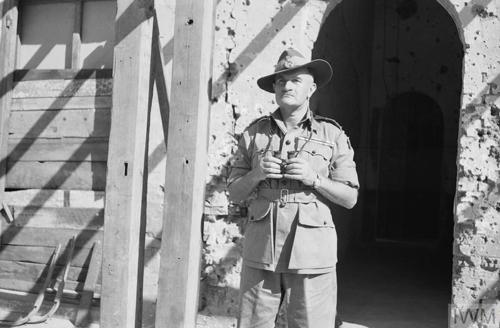21 July 2025
The March to VJ Day: The Battle of the Sittang Bend
Join us as we examine the last major battle fought by the Western Allies in the Second World War: The Battle of the Sittang Bend.
The Battle of the Sittang Bend
The Sittang

Image: The Sittang River (Wikimedia Commons)
Originating in Shan Hill’s mountainous highlands of the Shan Hills, southeast of Mandalay, the Sittang wends its way over 260 miles, through dramatic tree-lined countryside, before feeding into the sea in Myanmar’s Gulf of Martaban.
It’s a notoriously feisty waterway. The Sittang’s prominent tidal bore and fierce currents have historically prohibited all but the smallest, most manoeuvrable craft from navigating the river.
While the river runs through fairly flat country, the Sittang basin is separated from the mighty Irrawaddy by the rugged, teak-covered uplands and hills of the Pegu mountain range.
Monsoon rains engorge the river too, making it a formidable natural obstacle, and the river’s lower stretches are all but unfordable, especially once the monsoon arrives and the torrential rains come.
During the time of the Second World War, this ancient river was the site of two clashes between the forces of the British Empire and Imperial Japan, representing battles represent a dramatic shift in Japan’s fortunes.
In February 1942, retreating British forces blew the Sittang Bridge in a desperate attempt to slow the relentless Imperial Japanese Army’s advance. At that point, the Imperial Japanese, fresh from its conquests of Singapore and Hong Kong, seemed unstoppable.
A lot had changed between February 1942 and August 1945. The once all-conquering Japanese armed forces were now on their last legs, crushed by reorganised, reinvigorated British and Indian armies.
Now, alongside a kinked bend along the Sittang, the endpoint of the endurance-testing Burma Campaign had arrived.
The Situation in Burma

Image: Men of the Indian 19th Division get their first look at the Mandalay Hills on their advance through Burma (IWM (SE 3254))
At the time of the Second World War, Myanmar was known as Burma. The British Empire occupied Burma in 1886, integrating it into British India.
Burma became a separate colony in 1937, but just five years later, it traded one colonial ruler for another with the Japanese invasion of Burma in December 1941.
Japanese forces had pushed British and Indian troops out of Burma in early 1942. Initially, the British Imperial forces in Burma were poorly led, organised, and equipped, but with the appointment of General Bill Slim as commander of the British 14th Army in October 1943, everything changed.
A dynamic, diligent commander, Slim took great care to improve his men’s health and morale, including greater protection against diseases like malaria, which were taking as heavy a toll on the British as the Japanese themselves.
Indian and British servicemen were put through rigorous training programmes and learnt to adapt to jungle warfare, eventually becoming masters of combat in this most hostile of environments.
 Image: General, later Field Marshall, Bill Slim
Image: General, later Field Marshall, Bill Slim
Gradually, General Slim turned a ragged, demoralised army into a confident, well-equipped, motivated fighting force.
Slim’s tactical and strategic acumen were deployed at the Battle of Admin Box, during Operation U-Go: the attempted Japanese invasion of Burma in early 1944. Meeting the Japanese at the end of their supply lines, with his own reinforced and resupplied by air, Slim inflicted a major defeat on his adversaries.
The Japanese invasion of India was stopped dead at the Battles of Kohima and Imphal in the first half of 1944, with the British Indian forces enjoying their largest victory over the Japanese in the war to date.
Kohima and Imphal marked a decisive turning point in the war in Burma. Now the British and Indians, alongside troops from East and West Africa, had mastered jungle combat, were well equipped, and had a taste for victory.
What’s more, local guerrilla and military units, previously allied with the Japanese, had defected to the British side. Running a series of sabotage, harassment and commando campaigns, these forces would prove a major thorn in Japan’s side in the Burma Campaign.
By January 1945, the British were positioned to recapture Burma’s central highlands and its colonial capital, Rangoon. At the battles of Meiktila and Mandalay, Japanese forces in Central Burma were crushed.
From there, momentum shifted entirely towards the Western Allies.
Prelude to the showdown on the Sittang
British and Indian units had travelled some 300 miles down the Sittang towards southern central Burma in April 1945, intent on capturing the capital before the first monsoon rains fell.
Japanese forces did their best to slow the onslaught, but with the amphibious operation known as Operation Dracula, Rangoon was in Allied hands.
After Rangoon fell, British commanders took the opportunity to pause and rethink. Assigned to the upcoming invasion of Malaya (present-day Malaysia), 14th Army was replaced by the new 12th Army, covering British and Indian troops in the lower Sittang region, under the command of Lieutenant-General Montagu Stopford.
Trapping the Japanese

Image: 4.2 inch mortars of the 33rd Anti Tank Regiment waiting for action at the Sittang Bend (IWM (SE 4463))
During the retreat across Burma, the Japanese 28th Army had reached the Pegu Yoma, a range of low mountains, hills, and uplands nestled between the Irrawaddy and Sittang rivers.
The goal of the Burma Area Army (BAA), the main Japanese force remaining in central Burma, was to break out and escape into Thailand, avoiding defeat at the hands of the British. The 28th Army was hoping to join with the BAA.
However, its flight across Burma had essentially resulted in the 28th Army being trapped in the Pegu Yoma. They had been joined by men of “Kani Force”: a mixed brigade made up of anti-aircraft gunners, NCO school teachers, construction battalions and other non-frontline servicemen.
To reach Thailand and link up with the BAA, the 28th Army had to break out of its mountainous trap across the Sittang. To aid them, the Japanese 33rd Army, by now no larger than a brigade, was ordered to make a diversionary attack to the south.
Elsewhere, if the operation was failing, 15th Army would provide support to the 28th.
Unfortunately for them, the Sittang would prove just as formidable an obstacle for the Japanese as it had done for the British years earlier.
The battle begins
33rd Army’s Diversion
The Battle of the Sittang Bend began in earnest on 3 July 1945 with the Japanese 33rd Army’s diversionary attack. The Japanese were off to a bad start. Poor communications led 33rd Army to launch its attack a week ahead of 28th Army’s proposed start date.
British commanders allowed the Japanese to come within range of their artillery and tanks, where exposed infantry was cut to ribbons in a deadly fusillade.
In the air, the Royal Air Force's “cab rank” close air support provided extra firepower, with Spitfires and Thunderbolts striking from the sky to hit choice Japanese ground forces.
By 7 July, 33rd Army, after taking massive casualties, pulled back, hoping it had done enough to distract the British and allow their comrades to escape. As we know, this was entirely futile as the British knew every detail of the Japanese plan. British attention simply shifted to 28th Army.
The Breakout

Image: Burma - 14th Army: The Battle of the Sittang Bend. Men of the Queen's Own (Royal West Kent) Regiment Making an Armed Patrol (IWM (Art.IWM ART LD 5617))
When the main breakout came, it was a miserable experience for both sides. The monsoon had come, bringing driving rains and sweltering temperatures, creating less than ideal battlefield conditions.
On 15 July, in the face of the mauling their comrades had suffered earlier, 27th Army split into three columns and began its breakout attempt.
The British were waiting for them. Despite rains lashing the battlefield, forward observation officers were able to see through the deluge to direct British firepower onto two killing zones.
The first focused artillery on 12 Japanese crossing points along the river highway. The second, left for aircraft, targeted the road between the Sittang and the nearby Salween River.
For the Japanese, the breakout was a disaster. Their soldiers ran directly into heavily armed, well-prepared defensive positions. While tanks and infantry held up and repelled Japanese attacks, artillery and aircraft attacks wreaked havoc from the skies.
Wherever the Japanese struck, they were turned back. At Penwegon, for instance, the Japanese 55th Division attacked time and again, only to be defeated by the tanks and infantry of the 19th Indian Division.
The final attack

Image: No.607 Squadron pilots return after sorties at Sittang Bend IWM (CF 663)
1 July 1945 saw one final, desperate attempt by the Japanese to cross the Sittang River. Some 10,000 exhausted Japanese troops, riddled with cholera and dysentery, stepped out of the Pegu Yoma and began to cross the flooded paddy fields along the Sittang.
Every available British tank, infantryman, mortar, machine-gun, artillery gun and aircraft were thrown into the Japanese path. Such was the ferocity of the fighting that the all-important Allied forward observers were hit by shrapnel from friendly fire.
On 28 July, the Japanese made one final attempt to cross the river, but, sick and tired, the attack failed. The Japanese 15th Army went forward, but seeing the attack was a disaster, it retired on 29 July, having managed to rescue some of its isolated comrades.
Sporadic fighting took place in the coming week, but by 7 August, the whole area had been cleared by British infantry. The Battle of the Sittang Bend was over.
Battle of the Sittang Bend: Aftermath

Image: Japanese prisoners awaiting transportation into captivity (IWM (IND 4873))
The breakout had been a dismal failure for the Japanese. Losses had been horrendous. Japanese forces still showed immense courage in the face of overwhelming firepower but were unable to reach their goals.
Dead, dying, and defeated, the Japanese ability to wage war in Burma was effectively destroyed at the Sittang Bend.
Air power had been essential to the British victory. During the battle, the RAF flew over 3,000 sorties, dropping over 750 tons of bombs. The ferocious pounding meted out by Royal Artillery and the bombs of the RAF combined to inflict horrendous damage on the Japanese, with soldiers describing the battle as a “gunners war”.
Sittang Bend was the last major land battle fought by the Allies in the Second World War. With the British victory, Japan’s Burma Area Army effectively no longer existed as a fighting force.
Just over a week after the battle, the Imperial Japanese Government surrendered, bringing an end to the Second World War.
It would be some weeks before the remaining Japanese forces in Burma surrendered. On 13 September 1945, the remaining units of the Burma Area Army threw down their arms and surrendered to the British.
The war in Burma was finally over.
Casualties of the Battle of the Sittang Bend
It’s estimated that the Japanese took around 14,000 casualties at the Sittang Bend, including 8,500 killed. A further 5,000 succumbed to illness.
A further 2,000 died after the battle, in the days when ragged survivors did their best to march out of Burma.
Only 740 prisoners were taken, showing that, even in this late stage of the war, Japanese intensity and fanaticism had not diminished.
Comparatively, the British and Indian armies’ casualties were minimal. Less than 100 men were killed and just over 300 were wounded, mostly by friendly fire due to the extreme short ranges of some aspects of the fighting.
In fact, the British lost more to disease at Sittang than in combat, with some 1,500 men succumbing to sickness.
Discover VJ Day with Commonwealth War Graves
As we approach the 80th anniversary of VJ Day, we consider the impact today of one of the most gruelling campaigns of the Second World War. Commonwealth forces from across the then British Empire came together to fight in Southeast Asia - representing an enormously broad and diverse section of society, fighting for the freedom and values we enjoy today.
Join us for events, blogs, and virtual tours that help tell the story of the final months of this world-changing conflict, and how the work of the Commonwealth War Graves Commission hasn’t stopped since then.

